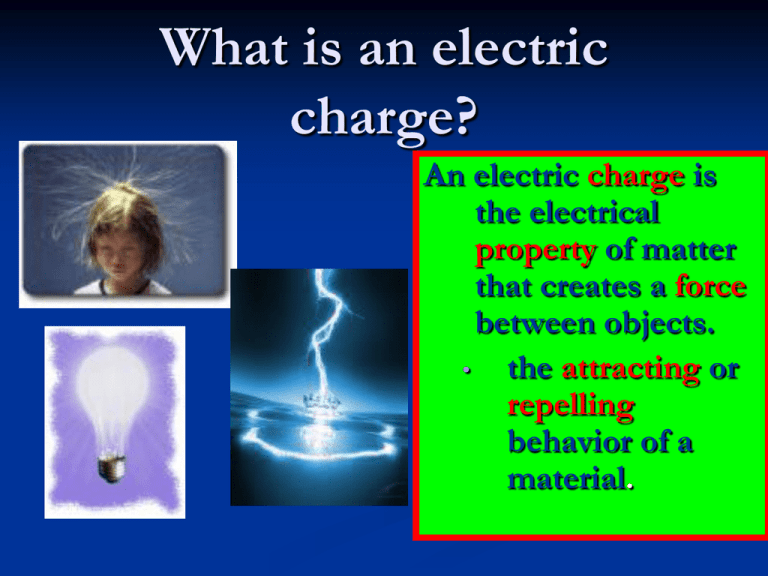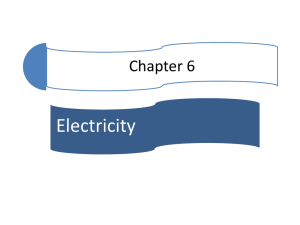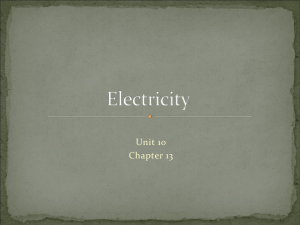Electricity Powerpoint
advertisement

What is an electric charge? An electric charge is the electrical property of matter that creates a force between objects. • the attracting or repelling behavior of a material. What is an electric charge? To create this charge, electrons must move from one atom to another. What is an electric charge? All matter is made up of atoms. Atoms are made up of smaller particles called protons, neutrons and electrons. Why do objects become charged? An imbalance of its protons and electrons occurs Protons positive, found in the nucleus Neutrons neutral, found in the nucleus Electrons negative, orbits the nucleus Conservation of Charge Electrons are bound more tightly to some atoms and molecules than others. When an electron is transferred, it creates an ion. Conservation of Charge A charged atom is an ion. positive ion – atom loses electrons negative ion – atom gains electrons Charge is always conserved – never created or destroyed! Conductors and Insulators ELECTRICAL CONDUCTORS Conductors allow electrons to flow Conductivity depends upon how tightly the atom holds on to its electrons. loose electrons in a material conduct the electric charge through (metals). Examples of conductors: Metal, graphite, etc. ELECTRICAL CONDUCTORS In solid conductors, the electrons carry the charge through the circuit because they are loosely held. In fluids, like those in a car battery, positive and negative ions and electrons may compose the flow of electric charge. ELECTRICAL INSULATORS Insulators DO NOT conduct electricity well!! They provide RESISTANCE to the flow of electrons. RESISTANCE IS CAUSED BY INTERNAL FRICTION Examples of Insulators: Glass, wood, rubber, etc. SEMICONDUCTORS Semiconductor – material made to behave sometimes as insulators and sometimes as conductors (germanium and silicon). Electric Fields An electric field surrounds every electric charge and exerts the force that causes other electric charges to be repelled or attracted. Electric fields are represented by arrows that show how the electric field would make a positive charge move. Charges Exert Forces Charges Exert Forces Unlike charges attract each other (positive and negative) Like charges repel each other (positive to positive or negative to negative) Charges Exert Forces Just like gravity, the amount of electrical force exerted on an object is related to the following: 1. Distance from the charged object 2. Strength of the charge on the charged object How can objects become charged? 1) Charging by Contact – Two objects are rubbed against each other and electrons are transferred. PROTONS NEVER MOVE from one atom to another. How can objects become charged? OR, A charged object touches a neutral object, transferring electrons – PROTONS NEVER MOVE from one atom to another How can objects become charged? Charging by Induction (charging at a distance) – A charged object is held near a neutral object and causes an overall charge. Charge Polarization When charges rearrange in an atom, one side becomes slightly more positive and the other side becomes slightly more negative. The atom is electrically polarized. Ex – charged comb attracting bits of paper or charged balloon sticking to the wall. ELECTRIC CURRENT What is current electricity? Current Electricity - Flow of electrons What causes electrons to flow? When an electric force is applied, it causes a potential difference or difference in voltage between the ends of a conductor. When there is no potential difference, the flow of charge stops. Direct Current and Alternating Current Direct Current – flow of charge always flows in one direction. Batteries use DC to flow from the negative terminal to the positive terminal. Alternating Current – electrons move back and forth about relatively fixed positions. Power utilities use AC. AC allows low-cost, high voltage energy transmission across great distances, with safe low-voltage use by the consumer. Potential difference or voltage difference causes electrons to flow in one net direction. This voltage difference provides the “push” or the “pressure” to move in a given direction, and the SI unit is Voltage (volts) Voltage Sources Voltage sources: dry cell batteries, wet cell batteries, leadacid batteries and generators. They supply the energy or the “push” to allow the charges to move. Voltage Sources Dry Cell Batteries Consists of two electrodes surrounded by an electrolyte. In the dry cell shown here, one electrode is the carbon rod and the other is the zinc container. Voltage Sources Wet Cell Batteries Contains two connected plates made of different metals in a conducting solution. Voltage Sources Lead-Acid Batteries Most car batteries are lead-acid batteries. Contains six wet cells made of lead and lead dioxide plates in a sulfuric acid solution. Voltage Sources In dry and wet cell batteries, a chemical reaction occurs releasing energy inside the cell which is then converted to electrical energy. Generators, like the alternators in vehicles, convert mechanical energy to electrical energy. Resistance Resistance is the tendency of a material to oppose the flow of electrons, changing electrical energy into thermal energy and light. Resistance Almost all materials have some electrical resistance. Conductors have less resistance than insulators. The SI unit for resistance is Resistance Temperature, Length, and thickness affect the amount of resistance of a material. Resistance increases as temperature increases. Resistance Resistance increases as wire becomes longer or as the gauge (diameter) becomes thinner. Electric current is the flow of electric charge and is measured in amperes (amps). Amperes can be thought of as the volume of current running through a circuit. Current in a Simple Circuit A simple circuit contains: 1)A voltage source 2)A resistor (such as a light bulb) 3)Conductors that connect the device to the voltage source. Current in a Simple Circuit Voltage, current, and resistance in a simple circuit are related. This relationship is known as Ohm’s law. Current in a Simple Circuit Ohm’s Law can be written as: V=IR V= Voltage I= Amperage (Current) R= Resistance Electrical Power Electrical Power is the rate at which electrical energy is converted into another form of energy, and can be written as: P=IV P=power I=Ampere V= Voltage ELECTRICAL ENERGY SERIES AND PARALLEL CIRCUITS What is a series circuit? A series circuit has only one path for current. SERIES AND PARALLEL CIRCUITS What is a parallel circuit? A parallel circuit has multiple paths for current. SERIES AND PARALLEL CIRCUITS For a circuit to allow the flow of electrons, it must be closed which means that it makes a complete loop back to the power source. SERIES AND PARALLEL CIRCUITS If it is open, the path that electrons can follow is broken and the resistor will not work. SERIES AND PARALLEL CIRCUITS If there is a short circuit, the resistor will not work, even though there is a complete path. The reason is because electricity will always follow the path of least resistance and will therefore not travel through the resistor. SCHEMATIC DIAGRAMS Schematic Diagrams are used to represent circuits. FUSES AND CIRCUIT BREAKERS How do fuses work? Fuses melt to prevent circuit overloads. A fuse is a ribbon of wire with a low melting point How do circuit breakers work? Circuit breakers open circuits with high current. Made of a magnet or bimetallic strip







